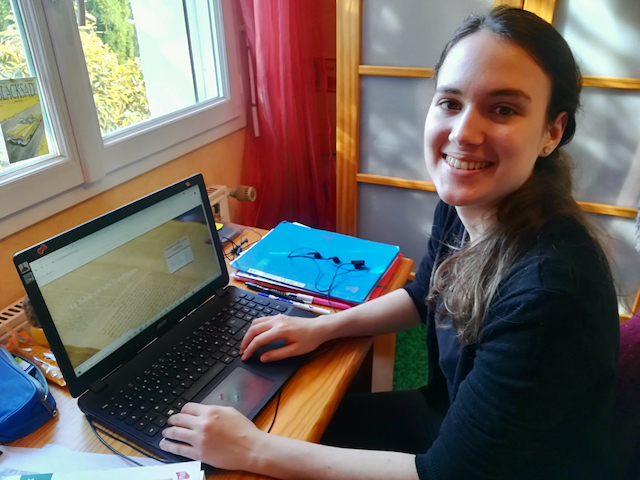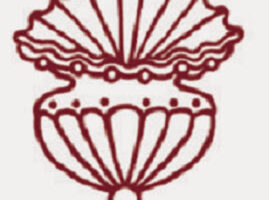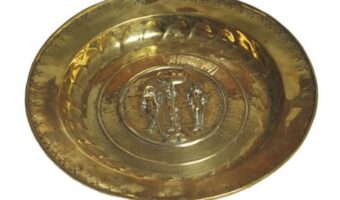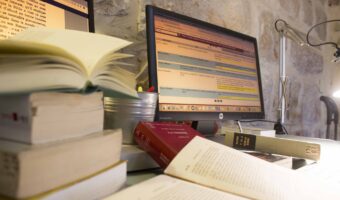Noémie Kirion
The cat on the keyboard, Ben Sira and Habacuc
« —My name is Noémie Kirion, I study in the Department of Ancient Sciences at the ENS in Paris and I have been participating in La Bible en ses Traditions since this year. I was supposed to go to Jerusalem in the fall of 2020, after obtaining my Master 2 on the Septuagint, but this project has been somewhat thwarted. It is therefore without taking a gap year and from my small Parisian studio that I began, from a distance, this collaboration. Since I no longer have a dissertation obligation, I organise my time between my classes and my homework to reread and annotate the books of Habakkuk and Sirach. This work is a bit more solitary than expected, but fortunately it is accompanied by Skype exchanges which prevent me from drowning in my translations!
This “homework” does present some difficulties. The connection problems, Skype only working on the phone; the daily noise of the drills in the building – eventually leading me to flee Paris for the family home; the cat banging on the window during video conferences, or walking on the keyboard, threatening to shut down an already tired computer. But, once all these trials have been overcome, what a pleasure it is to arrive at the much hoped-for translation! The search for the most effective way of translating, the comparison of texts in different languages, which can both clarify and contradict each other, is what makes this project so interesting for me, and gives relief to my own studies of the biblical languages.
I am in charge of rereading the translation into French of texts from a Vulgate that has not yet been translated into that language. I was immediately enthusiastic about this, especially as the book of Ben Sira is the subject of my two dissertations. I was discovering Habakkuk, but with its translation still very much unedited, I found the challenge very exciting. I try to ensure that the French remains understandable without betraying the original text too much, which requires an exciting exercise in reflection.
I particularly appreciate the decision to keep the translation as close to the text as possible, which leaves room for its ambiguities and brings out its poetry, but sometimes leads to obscure puzzles! Nothing, however, that a little discussion cannot solve, which is what makes this collaboration so interesting. It’s a great way to get some motivation and exchange in a year when I can’t even attend my classes in person!
Sr Mary Dominic Pitt O.P.
Every weekday, a little bit of Jerusalem comes to Nashville, Tennessee.
“My days are now filled with the work for BEST for several hours in the morning and several hours in the afternoon. To find a strong and elegant translation, as literal as possible, means complete and joyful absorption at each sitting. I transliterate and align all five versions in the polyglot to compare both shared and unique features. The next step is to look for fascinating philological details—grammar, etymologies, classical figures of speech, syntactic discrepancies, and semantics—all features that shed light on the ancient writer’s choice of words and word order. My tools are the texts themselves and a grammar and lexicon for each.
In the lively text of the Book of Revelation, the feet of the Son of Man shine like “brass of Lebanon” (1:15), not only a land of fine brass but also of mountains whose white snow is perfection (1:15). Six wings are attached above the “toenails” of the four living creatures, a single Syriac word simultaneously identifying the man, the lion, the calf, and the eagle! (4:8). The angels adoring the Lamb are not only thousands but dynamic myriads circling the Throne (5:1). Only after weeping does the visionary notice the Lamb for the first time (5:6).
Participles, finite verbs, and perfect aspect often occur across the versions all in the same verse or even in the same word, natural language seeming unable to express the timelessness of Heaven!
A satisfying translation and notes are themselves the reward. I am grateful to my colleagues in Jerusalem for allowing me to work on the BEST project for L’École Biblique!”
Thomas Costrel de Corainville
Of my little stone in the cathedral under construction
“My relationship with the digital cathedral under construction that is the BEST is not primarily that of a contributor. As the editor of the small newsletters and now articles of PRIXM, I know the BEST mainly for the resources it allows me to discover, for its countless doors of entry into exegesis and Bible study. In other words: it is above all as a reader that I always enjoy reading the historical and archaeological analyses, the grammatical commentaries or other remarks on biblical intertextuality – all these categories and sub-categories which make the charm of this platform, true formal vaults, supporting the general architecture!
But now that the PRIXM articles have been republished on the site, their pedagogical findings simply deserve to return to their main source: the BEST. It is therefore a job of craftsmanship that I am doing to create new notes. These new notes make a modest contribution with new musical pieces inspired by the Scriptures, little-known paintings, but above all new reading proposals.
Each PRIXM article becomes a proposal, a small square in the immense mosaic that is currently being built. A small square in the immense mosaic that is still being built: the Spirit never stops blowing, so the project is infinite!
But my enthusiasm stems precisely from this audacity to build not the presumptuous infinity of Babel, but an infinity that beckons, because Scripture inspires.As a collaborator in this immense project, we have not finished “playing together”: just as the greatest artists, writers, historians or philosophers still find readers to pick up the trail of their thought and trace a new path; so too will tiny notes perhaps find a reader to detect an element on which he will bounce back, on which he will build a new column, a new vault.
Thus, I am confident that the tiny squares brought into this immense mosaic will find their place and their colour, through continuous repetition and inspiration. In any case, this is my joy as a small craftsman at the heart of this stirring site!
Arnaud Mistral
On the argument of things that are only apparent
“You search the Scriptures because you think you will find eternal life in them, but the Scriptures bear witness to me” (John 5:39).> The reading of this verse brings me back to the work entrusted to me in the framework of BEST. In charge of proofreading the translation of the Latin version of Saint Jerome, known as the Vulgate, I have to harmonise, correct and check that the text presented in the BibleArt application, which is currently being ‘beta-tested’, is entirely readable. Although this mission often consists of removing commas or correcting certain line breaks, it is not unusual to come across cases whose interest gives my work a higher value. Indeed, by scrutinising the Scriptures, one realises that slight nuances between versions, or seemingly unimportant ambiguities, ultimately reveal major issues.
For example, in rereading the Epistle to the Hebrews this Lent, I found in chapter 11, verse 7, in a passage praising the faith of the patriarchs:
“By faith Noah, having received an oracle concerning that which was not yet visible, with fear built for the salvation of his house an ark, by which he condemned the world; and of righteousness according to faith he was made an heir.”
Commentators and translators often understand the word which refers to the ark. Thus, the building of the ark becomes a condemnation for the world as it brings about God’s judgment against unrighteous men through the flood.
In the Vulgate, however, the feminine of per quam can refer both to the ark (arca) and to the faith (fides) that the author praises in this chapter. It is then through Noah’s faith that the world is condemned! This is how Thomas Aquinas understands the text and comments on it:
“Noah, because he did these things because of faith, condemned the world, that is, showed that those who lived in this world were worthy of condemnation. Noah’s faith is a condemnation of the world because it manifests the iniquity and unfaithfulness of the world. Noah’s faith thus manifests the definition given by the author of the epistle at the beginning of the chapter: “the substance of things to be hoped for, the argument that proves things that are only apparent”. Noah, by his faith, hopes for justice for himself and for the world, holding fast to the certainty of God’s justice in spite of the apparent wickedness and perversion of men throughout the earth.”
Thomas then adds:
Thomas then adds: “For as after death one comes into possession of the inheritance of him who possessed it, so from the beginning of the world righteousness had not yet entirely disappeared from this world, since it still remained; but at the flood this world perished almost entirely, and then Noah became by his faith as the heir of the righteousness which springs from faith. The faith of Moses was the only remnant of righteousness in the midst of evil men, and this faith became a living reproach to the world.
Thus, a slight ambiguity that might go unnoticed can be an opportunity to deepen the text. An ambivalence can be the source of two understandings, which without contradicting each other, enrich the text with new and unsuspected dimensions. It is then that the relationship between the Bible and its interpretative traditions takes on its full meaning and allows us to rediscover the living depth and richness of the text.
« “Living indeed is the word of God! » (He 4, 12)

.jpg)





